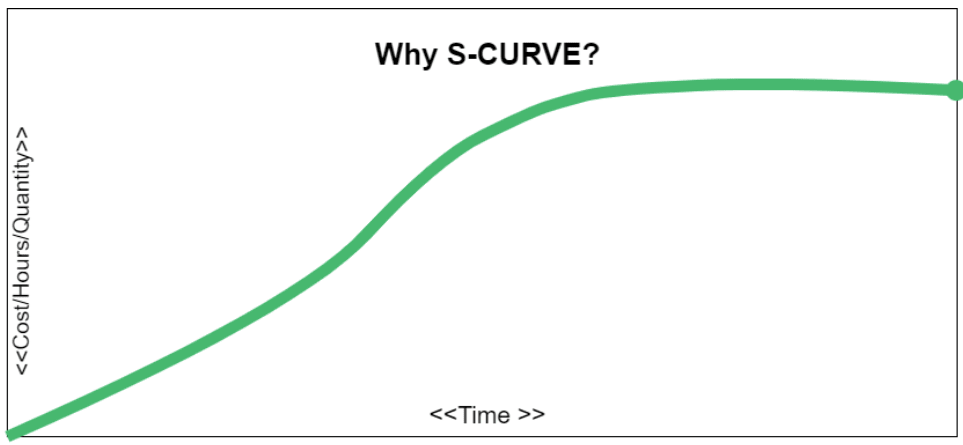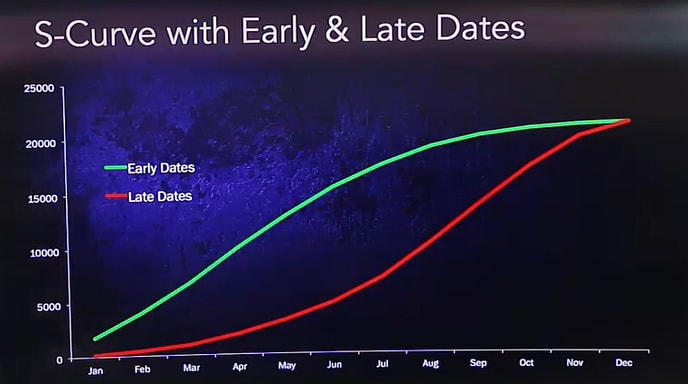If you’re a project manager, you know that tracking progress against a plan is everything. But how do you visualize that progress in a way that’s easy for everyone to understand? Enter the S-curve.
An S-curve is a simple graph that plots cumulative project data—like costs or man-hours—against time. Its distinctive ‘S’ shape provides a powerful, at-a-glance view of your project’s entire lifecycle. In this guide, we’ll break down what an S-curve is, how to use it, and most importantly, how you can create and track one directly on monday.com.
Get started with monday.comTL;DR: An S-curve is a visual representation of a project’s progress over time, showing slow initial and final phases with rapid work in the middle. It’s a key tool for tracking costs, hours, and overall performance against the original plan.
What is an S-curve in project management?
An S-curve is a mathematical graph that visually represents cumulative project data, such as cost or man-hours, plotted against time. It gets its name from the characteristic ‘S’ shape the data line forms throughout a project’s lifecycle. This graph is an essential tool for project managers, offering a high-level overview of project progress and performance.
Why does a project’s progress form an “S” shape?
The ‘S’ shape isn’t random; it reflects the natural rhythm of most projects:
- The Beginning (Bottom of the S): Progress is slow at the start. The project team is assembling, plans are being finalized, and initial tasks are just getting underway. This phase involves more planning than execution, resulting in a relatively flat line on the graph.
- The Middle (Steep part of the S): Once the project is in full swing, growth accelerates rapidly. The bulk of the work is completed here, resources are fully deployed, and man-hours and costs climb steeply. The steepest point of this incline is known as the inflexion point, representing maximum project activity.
- The End (Top of the S): As the project nears completion, activity slows down. Final tasks are wrapped up, deliverables are handed over, and the project moves toward closure. This causes the curve to level out again, completing the ‘S’ shape.

The benefits of using an S-curve for project tracking
An S-curve is more than just a graph; it’s a powerful decision-making tool. By comparing your planned S-curve (the baseline) with your actual progress, you can quickly identify variances and take corrective action. Here’s how it helps:
- Track project performance: According to the Project Management Institute (PMI), many projects struggle to stay within their original budget. A baseline S-curve allows you to monitor actual spending and progress against your plan, making it easier to stay on track.
- Forecast resource needs: The curve shows you when project activity will peak, helping you plan for cash injections or additional team members. This makes resource management more accurate and proactive.
- Manage stakeholder expectations: S-curves are a simple, visual way to communicate the project’s expected pace. You can show stakeholders why progress might be slow initially and when they can expect to see rapid development, keeping everyone aligned.
- Plan for different scenarios: By plotting earliest and latest start dates for tasks, you can create a “banana curve.” This visual range shows your project’s scheduling flexibility, or ‘float,’ helping you assess the risk of delays if things change.
![]()
Common types of S-curves
Cost S-curve
This is the most common type, plotting cumulative project costs over time. It helps you track actual spending against the budgeted cost, making it a vital tool for budget management and forecasting.
Man-hours S-curve
This curve tracks the cumulative work hours of the project team. It’s essential for resource planning, helping you see if your team is working more or fewer hours than planned and allowing you to adjust your recruitment process accordingly.
Progress S-curve
This curve plots the percentage of work completed over time. It provides a clear picture of how the project is advancing against its project timeline and helps identify potential delays before they become critical.
How to analyze an S-curve (Planned vs. Actual)
The real power of an S-curve comes from comparing your baseline (planned) curve with your actual data. This is a core part of Earned Value Management (EVM), a technique that integrates scope, schedule, and resources. The variance between the two curves tells a story:
Scenario 1: Actual curve is above the baseline
If your actual cost curve is above the planned curve, it means you are over budget. If your actual progress curve is above the baseline, you are ahead of schedule. This could be a positive sign, but it might also indicate that the team is rushing or spending too quickly.
Scenario 2: Actual curve is below the baseline
If your actual cost curve is below the baseline, you are under budget. This is often good news, but it could also mean that work is not being completed as planned. If your actual progress curve is below the baseline, your project is behind schedule, and you may need to take corrective action to get back on track.

How to track S-curve metrics with monday.com
Forget exporting data to create graphs manually. With monday.com Work OS, you can track all the metrics needed for an S-curve directly within your project boards and visualize them in real-time using powerful Dashboards.
Here’s how you can do it:
- Set up your project board: Start with a project plan template and add columns for planned costs, actual costs, planned hours, and actual hours (using the Time Tracking column). Assign deadlines to every task.
- Create a Dashboard: Add a new Dashboard to your workspace and connect it to your project board.
- Use the Chart Widget: Add the Chart Widget to your Dashboard. Configure it to display cumulative data. For a cost S-curve, set the X-axis to a time-based column (like a deadline or date column) and the Y-axis to your planned and actual cost columns.
- Analyze in real-time: The Chart Widget will automatically generate a graph that functions just like an S-curve. As your team updates tasks and logs time or expenses, the chart will update in real-time, giving you a live comparison of planned vs. actual performance.
You can create multiple charts for different metrics, such as man-hours or task completion, giving you a complete performance overview for your entire portfolio management.
Visualize your project’s progress. Build your first S-curve dashboard on monday.com.
Get started with monday.com
Limitations of S-curve analysis
While S-curves are incredibly useful, they do have limitations. A key one is that they show *what* is happening (e.g., you’re over budget) but not *why*. A variance could be due to a single expensive task or a systemic issue across the project.
For this reason, S-curves should be used as a starting point for deeper investigation. When you spot a deviation on your monday.com dashboard, you can drill down into the specific tasks, check updates, and collaborate with your team to understand the root cause and find a solution.
Start tracking your projects with clarity
S-curves transform complex project data into a simple, visual story of progress. When powered by a flexible platform like monday.com, they become a dynamic tool for keeping your projects on time and on budget. Ready to see it in action?
Get started with our free Project Cost and Progress Tracking Template.
FAQs
What's the difference between an S-curve and a bell curve?
An S-curve tracks cumulative data over time (like total cost to date), so it always trends upward. A bell curve, on the other hand, shows the distribution of data at a specific point in time, like the number of resources used per week, which rises and then falls.
Can an S-curve be used for Agile projects?
Yes, but with a different approach. Instead of a single S-curve for the entire project, you can use multiple, smaller S-curves to track progress within each sprint or iteration. This helps monitor progress in a more flexible, adaptive environment.
What software can I use to create an S-curve?
While you can use spreadsheet software like Excel, a dedicated Work OS like monday.com is far more efficient. On monday.com, you can use Dashboards and the Chart Widget to create live, S-curve-style graphs that update automatically as your project progresses, eliminating manual data entry.
How does an S-curve relate to Earned Value Management (EVM)?
The S-curve is a foundational tool in EVM. It visually represents the key EVM metrics: Planned Value (PV), which is your baseline S-curve, and Actual Cost (AC). When you also plot Earned Value (EV), you get a complete picture of your project's schedule and cost performance at a glance.
Don’t miss more quality content!
